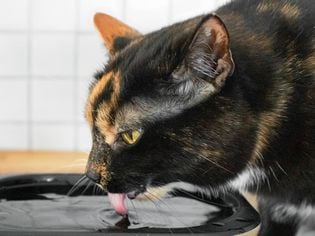When cats live in multi-cat homes, catteries, or shelters, they're more susceptible to the spread of infectious diseases. Feline chlamydia (Chlamydophila felis) is a very common bacterial infection, and this illness can also spread to the lungs when left untreated. Unlike chlamydia in humans, this disease typically affects the eyes and upper respiratory tract in cats. Owners may notice symptoms like eye and nasal discharge, sneezing, fever, lethargy, and even squinted eyes.
Cats can develop this eye infection through direct contact with the bacteria when it is present on another cat. Any ocular or nasal secretions are considered to be infectious. C. felis doesn't survive long in the environment, so shared litter boxes, bowls, and toys (which should still be properly disinfected) are unlikely to cause transmission. Although any cat can become infected by C. felis, young cats and kittens are the most susceptible. Caretakers can learn the signs of feline chlamydia along with prevention methods to help keep their cats healthy.
What Is Feline Chlamydia?
Chlamydia in cats (sometimes called chlamydial conjunctivitis) is a bacterial infection caused by the bacteria Chlamydia felis that typically infects the eyes and upper respiratory tract. This bacteria invades and infects a cat's eyes, nose, and throat.
C. felis is one of the most common causes of conjunctivitis in cats. While the transmission is unlikely between cats and humans, it is still possible for feline chlamydia to affect people that come into contact with infected cats—so caretakers should practice regular sanitization methods during any outbreaks.
Symptoms of Chlamydia in Cats
It typically takes between three and 10 days for cats exposed to chlamydia to develop symptoms. At this point, the symptoms become more severe, and they can persist longer when left untreated (which can lead to infections of the lungs). The most common symptoms of chlamydia in cats affect the eyes and upper respiratory tract. Owners may observe the following:
Eye Discharge
Typically, the first sign of feline chlamydia infection is watery eye discharge. This can infect one or both eyes. This fluid will progress to a thicker, yellow, or even greenish-colored discharge. You may notice that your cat's eyes start to look noticeably irritated, and it may squint (holding one or both eyes closed due to pain).
Sneezing and Nasal Discharge
If your cat becomes infected with C. felis, you may also observe mild sneezing and nasal discharge. Your cat may begin to sniffle as a runny liquid is emitted from its nose.
Fever
Similar to other infectious diseases, chlamydia can cause cats to develop a fever. The cat may shiver, appear weak, and have an increased heart rate.
Lethargy
Often accompanied by a fever and loss of appetite, your cat may become lethargic during a chlamydia infection. Seek veterinary attention to help ensure your cat doesn't become dehydrated.
What Causes Feline Chlamydia?
Young kittens are the most susceptible to developing chlamydia, but this condition can affect any cat (especially those living in multi-cat households, catteries, and shelters). This feline disease is spread by the following cause:
- Transmission from another cat: Cats contract feline chlamydia from an infected cat. This often happens when cats socialize and mutually groom each other, although it can also occur when cats are simply in close contact together.
How Vets Diagnose Chlamydia in Cats
If you suspect that your cat has contracted C. felis, it's important to schedule a veterinary exam as soon as possible. Upon arrival, your vet will perform a physical exam, including a thorough look at your cat's eyes.
Your veterinarian will need to determine whether your cat was exposed to C. felis or another bacterial infection that can affect the eyes. To confirm the diagnosis, they'll take a swab from the conjunctival membrane to be examined under a microscope in the laboratory after growing a culture.
The veterinarian may also perform a fluorescein stain to check for a corneal scratch or a Schirmer tear test to assess your cat's tear production. A corneal scratch can also cause an increase in eye discharge and eye squinting. Your cat may develop a corneal scratch or ulcer if it is rubbing its eye (due to pain) and accidentally scratches it. However, a positive fluorescein stain test is not a hallmark of chlamydial infection. Likewise, if your cat has dry eye, its eyes may produce a thicker, more yellow-colored discharge than normal.
To more definitively diagnose chlamydia in your cat, the vet may also send these swabs out to a lab for a specialized test called a Polymerase Chain Reaction (PCR). This test amplifies the bacteria on the swab in order for the lab to identify it.
How to Treat Chlamydia in Cats
If your cat is diagnosed with chlamydia, your veterinarian's first choice of treatment will be an oral antibiotic known as doxycycline. If your cat has any known allergy to doxycycline or to other tetracyclines, be sure to tell your veterinarian so they can prescribe a different antibiotic.
If your cat is in noticeable discomfort—or if the symptoms seem severe enough—your veterinarian may also prescribe a topical eye ointment or drops to give in conjunction with the oral antibiotics. Oral antibiotics are more effective at fighting this type of infection. Topical treatments should always be used with your veterinarian's instructions, most often alongside an oral medication.
Medications for feline chlamydia should be used for a minimum of four weeks, plus an additional 10 days until all symptoms have completely cleared. All cats within the household should be treated at the same time, as some cats may have delayed symptoms or be asymptomatic but still contagious.
Prognosis for Cats With Chlamydia
Some cats may experience more severe symptoms than others, but most cats that become infected with feline chlamydia can recover fully with proper care and treatment. However, without treatment, this disease can lead to severe respiratory infections. Kittens and young cats that become infected with feline chlamydia can develop life-threatening cases of pneumonia when the infection spreads to the lungs. For this reason, it's especially important for owners and caregivers to treat cats consistently under a veterinarian's supervision.
How to Prevent Chlamydia
There are a few different methods of prevention that owners and caregivers can use to protect their cats from feline chlamydia. These include vaccines and limiting exposures:
Vaccines
There is a vaccine available for feline chlamydia. However, its protection is not permanent: Owners will likely need to schedule follow-up vaccines annually for cats that are considered at-risk. If your cat lives alone in your home, this vaccine is usually not necessary unless the cat has a history of contracting chlamydia. Your veterinarian can help you determine your specific cat's risk level.
Limiting Exposures
If you have multiple cats living in the same household, it's important to limit exposures (and therefore, risk) to the best of your ability. Keep your cats indoors. Cats that spend time outside—even if only for a few minutes a day—may come into contact with other infected cats in your area. Some regions may have a higher volume of feline chlamydia cases than others.
Is Feline Chlamydia Contagious to Humans?
The bacteria C. felis is highly adapted to infecting cats, so the risk of humans contracting chlamydia from their cats is low. However, if one of your cats has been diagnosed with this disease or is suspected to have it, you should practice good hygiene and sanitization procedures after handling the cat until the infection is fully cleared.










Comments on " Chlamydia in Cats" :